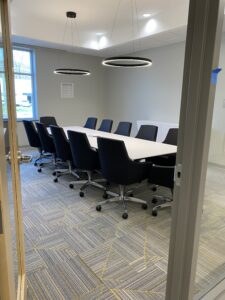As the strains from the COVID-19 pandemic lessen, some employers are increasingly providing workplace amenities to entice workers back to the office. Hanna Snyder Gambini writes about this in her article titled “Employers turn to amenities to lure workers back to the office,” published November 21st in the Hartford Business Journal.

From soundproof phone booths to golf simulators, Connecticut Wealth Management is kicking out the cubicles in favor of spaces it hopes will foster better workplace collaboration and comfort in equal measure. By allowing employees to partake in activities after work that they’d normally have to leave the office for, CTWM aims to strengthen workforce ties.
Communal spaces that seem more like lounges instead of seas of cubicles is where workplace design is headed. Airy, open spaces that encourage interaction are the goal. But privacy, and the comfort it provides, is just as important to this design philosophy and was what led to the introduction of soundproof phone booths and Steelcase work tents.
Another means to support workplace collaboration and minimize distraction is addressing the rising costs associated with commuting. Lunch and gas costs being the main culprits, some employers are investing in desirable cafeteria settings. Travelers Cos., a property and casualty insurer, did precisely that in Hartford with a space that offers numerous food and drink venders and seats hundreds of employees.
Changes to the office environment should be a two-prong approach explains Jennifer Gaggion, a Board Member of the Connecticut Manufacturer’s Resource Group. “It’s imperative that design changes include the input of HR to ensure the transformation of the workplace can be supported culturally and aligns with the business strategy.
Should more large companies require employees to come into the office, we may start to see workplace landscapes re-emerge and working-from-home diminish. For now, though, according to an HBJ poll referenced in the article above, most employers aren’t requiring five full days back in the office just yet.
“We’ve learned working from home can be highly productive for organizations. Now it’s a matter of striking a balance by creating spaces that foster the desire to return to the office – even if only for a modified week.”
This transitional period is pivotal in establishing and re-establishing workforce synergy. If your business is seeking assistance designing an environment befitting its workplace culture, feel free to contact the Connecticut Manufacturers Resource Group.